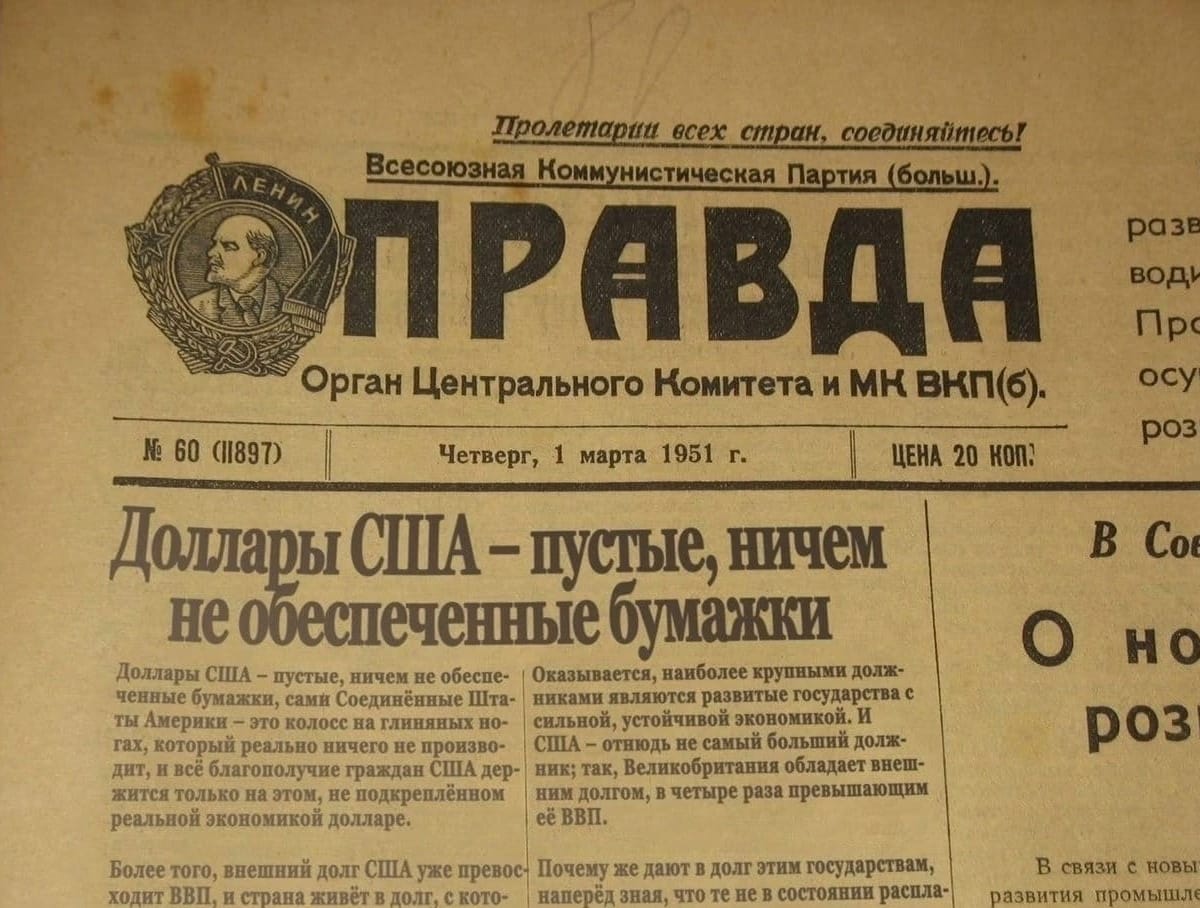Recently, a photo of the front page of the main Soviet newspaper has been spreading across the Internet, on which the American currency is given a derogatory description. We checked whether such a note was actually published.
On December 27, 2022, Russian opposition politician Gennady Gudkov published tweet with the words “Since 1951, propaganda in Russia (USSR) has not changed.” This statement referred to the attached photograph of the front page of the Pravda newspaper dated March 1, 1951, which featured an article with the following content: “US dollars are empty, unbacked pieces of paper, the United States of America itself is a colossus with feet of clay that really produces nothing, and the entire well-being of US citizens rests only on this dollar, not backed by the real economy. Moreover, the US external debt already exceeds GDP, and the country lives in debt, which is even theoretically impossible to pay off. It turns out that the largest debtors are developed countries with strong, stable economies. And the United States is by no means the biggest debtor; Thus, Great Britain has an external debt four times greater than its GDP. Why do they lend to these states, knowing in advance that they are not able to repay?”
Gudkov, whose tweet caused a great resonance, was far from the first distributor of this photo - in the fall and winter of 2022, it went around such resources as JoyReactor, Reddit, "I cried", as well as a number Telegram—channels.
First, let's pay attention to some features of the article presented in the picture.
1. The publication about the dollar is entirely in bold, which is not typical for the Pravda newspaper. In articles in this publication, it was customary to highlight individual fragments (for example, quotes), but not the entire text.

2. The text of the article differs in shade from all other graphic symbols on the front page of the issue. Moreover, only in the article about dollars, none of the letters lost their color over time (this is noticeable by the absence of light dots):

These were technical notes. But there are also meaningful ones.
1. At the time the issue was published, the term “GDP” was practically not used in Russian. This should from an analysis of publications from the early 1950s.
2. Comparative statistics of countries’ external debt published World Bank since 1973. Until this point, such data was only available selectively - a much more commonly used indicator was government debt. However, public data suggests that UK foreign debt in the early 1950s amounted to about £2 million - an amount equivalent not to four GDPs, but approximately one sixth to seventh parts of it.
However, the most reliable way would be to see the newspaper issue directly. IN archive There are no materials from the Pravda newspaper for the early 1950s. However, the specified release dated March 1, 1951 can be found on some online auction sites. Here's his front page:

As you can see, the number is the same in many ways, but the article on the left side of the front page is completely different. It is called “New Reduction in Retail Prices” and is dedicated to intra-Soviet realities. This is a rather significant text for Soviet history - to it, in particular, in March 2020 applied leader of the Communist Party of the Russian Federation Gennady Zyuganov on his social networks.
Moreover, apparently, the basis for Photoshop was the photograph posted on the auction website - identical pencil inscriptions and stains are visible on the photographs.

Where did the text placed on the viral photo come from? In Russian-language publications, dollars have been called empty, unsecured pieces of paper before - for example, this phrase can be found in Maxim Kalashnikov’s book “Global crisis of turmoil", first published in 2009. However, the entire fragment appears to have been copied from the article “When the dollar collapses”, published in 2016 by a certain Lev Olshansky on the website “Proza.ru”. Moreover, Olshansky approached the topic critically (“A number of media outlets convince Russians that US dollars are empty, unsecured pieces of paper…”), but the authors of the fake turned the meaning of his words around. Fake photo start spread on the Internet in the first ten days of September 2022.
Cover photo: Telegram.
Fake
If you find a spelling or grammatical error, please let us know by highlighting the error text and clicking Ctrl+Enter.






